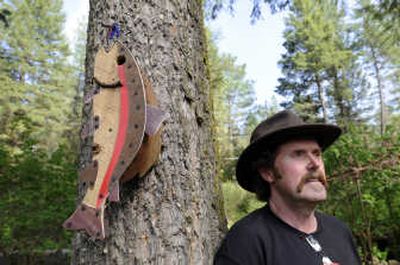Something old, something new

When Steve Baran started making birdhouses more than a decade ago, he used all new materials. A chance find, however, turned him on to more environmentally friendly sources.
“In 1992 we moved to the Little Spokane River, just north of Chattaroy, and there were birds everywhere,” Baran says. “So I bought a birdhouse book and started making some, but I wasn’t that good at that type of carpentry. In my haste I’d be making mistakes, so I’d have to go buy some more wood. Then I saw someone’s fence was knocked over, and I asked, ‘Could I use this wood?’ So I started using old wood, and I got better.”
Now he gathers old wood, metal and glass to use in his birdhouses, which he sells through his business, Fowl Places. His stockpile of material is so big, he had to build a new storage area on his property.
Everything is recycled except the connecting hardware. Baran uses a plane to smooth out old barn and fence boards that are peeling. He never paints or stains the inside, and rarely the outside, instead relying on the wood’s natural color. Old glass and porcelain insulators provide weight for the hanging houses or are just for décor.
“I like reusing materials,” Baran says. “And what’s fun about that is that I get to go find it. And a lot of the stuff I’m actually picking up off the ground somewhere or dragging it down off the hillsides.”
The metal edging he puts around all the entryways come from an old aqueduct system or iron banding. This rim prevents squirrels and flickers from enlarging the holes.
“Red squirrels can squeeze into an inch and three eighths, and flying squirrels, too,” Baran says. “I didn’t know we had those until I was cleaning out one of our duck boxes and they ran right out over my back and then flew to an adjacent tree.”
Baran began with traditional designs then expanded into more fanciful styles, inspired by books, the Audubon Society Web site and other birdhouse builders. “Jumping Trout” is the name of his design patterned after the salmon, where the actual birdhouse is in the shape of a fish. He also has made houses in the shapes of birds and stars.
Different species require different nesting compartment and hole sizes. All houses should have some kind of entry that can be opened without tools, so homeowners can clean the compartments easily. Birds don’t live in the houses full time, only to raise their families. Once the young have fledged, Baran cleans the houses for the next family. He never uses detergents, just a brush and hose then lets them dry. First he checks for inhabitants.
“I’ll knock on everything before I check them, and I rattle them a little bit,” Baran says. “And then I’ll open up the box slowly to see if I can see anything in there.”
In his yard are 12 duck houses, half of which are occupied by wood ducks, several hanging and single nesters, and a variety of multiple nesters, with one 16-plex. The latter is never fully inhabited though, as birds dislike crowded conditions.
First Baran sketches a design then he draws it on graph paper to get the dimensions correct. Sizes range from 4 to 14 inches in height. He does custom work, such as two pairs of matching houses for a wedding arbor and a special one-of-a-kind design for his wife for Valentine’s Day.
Baran offers tips for the potential birdhouse owner. Never have perches, as that can give predators a foothold. Don’t feed too close to your own home, as birds prefer privacy. Never use toxic or lead paints, especially on the inside. If your birdhouse is vacant, it could be positioned in the wrong location or at the wrong angle. Try moving it.
Also, don’t put houses in the full sun, as that can attract European paper wasps that build nests in the apex. Once established, these wasps are very persistent. The nests can be knocked out, but they’ll return the next day. Frequent contact with the houses isn’t recommended.
“Birds tolerate a little bit of human interaction. If you were going to be at the site a lot though, then it could cause problems,” Baran says. “The more you’re at the site the more you’re leaving scents of your own. And that can bring predators to a location.”